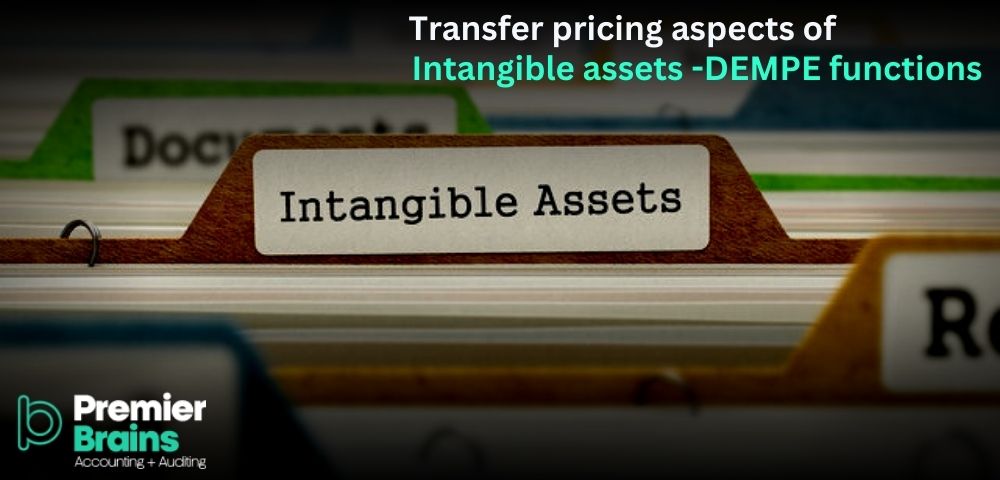Intangible assets: According to Organisation of Economic Cooperation and Development (OECD) intangible assets are “something that is not considered as a physical asset or a financial asset, and that is capable of being owned or controlled for use in commercial activities”. Few examples of intangible assets include goodwill, brand recognition, licences, trademarks, patents, copyrights etc.
DEMPE: Development, Enhancement, Maintenance, Protection and Exploitation. There are few of the factors to be taken into consideration when determining who is performing what function, which are: control, funding, and risk.
The OECD first introduced the concept of DEMPE in the 2015 Final Report on Actions 8-10, "Aligning Transfer Pricing Outcomes with Value Creation," released in October 2015. DEMPE is formulated to assist taxpayers and tax authorities to achieve an accurate evaluation of certain transactions in order to determine appropriate transfer pricing, identification of entities performing DEMPE functions and ensuring an arm’s length return for them.
According to the OECD’s BEPS-project (‘Base Erosion and Profit Shifting’), rather than focusing on legal terms, taxation, must be aligned with the economic reality of the transactions. This similar principle is also applied when transfer price for intangible assets were determined and described in action 8-10 of the BEPS project. For instance, in a case where an entity is considered to be the legal owner of an intangible asset it does not mean the entity has right to all the profits relating to that intangible asset.
The revised OECD Transfer Pricing Guidelines mentions that if an entity only has the legal ownership of an intangible asset (and not the economic ownership), then that entity should only receive a certain amount of remuneration for its legal ownership. The residual profit resulting from that intangible asset, on the other hand, should be allocated to the intangible asset’s economic owner.
To ascertain if an entity has economic ownership of an intangible asset, it is prescribed by the OECD guidelines that the “DEMPE functions” performed by the entity should be outlined. These functions include:
Development: Upcoming ideas with regard to intangibles for the brand and its related products and preparation of its plans and strategies for their creation.
Not just a single entity but each one of the brand’s entities are responsible to take part in various steps of the development process even though some of their functions may overlap. Several entities may focus on certain functions such as initial brand development, acquisition of technology licenses and may contribute less to the establishment of quality standards for manufacturing process, which on the other hand will be handled by other entities. Some of them may get involved in development of “enhancement strategies” for various product lines as well as setting up sales procedures, refining user experience and creating online client platforms.
Enhancement: Working on the various aspects of intangibles in order to improve their performance and ensure they keep performing well.
Being mostly identical to the development stage, the functions, and responsibilities in relation to enhancement are also divided between various entities. While few entities may focus on brand promotion and enhancing its awareness. Others may focus on enhancing the manufacturing process, improving the client purchase experience, encouraging client interaction as well as enhancing the existing technology.
Maintenance: Keeping a check on their performance overall along with ensuing enough revenue generation.
Maintenance completely focuses on client experience and quality checks, while few entities are responsible for customer happiness, making sure the sales experience was consistent, nurturing customer connections, monitoring client feedbacks as well as make sure that when customer feedbacks are collected these issues are addressed through constant enhancements, revisions, and updates. Other entities are responsible to make sure the quality of the products and processes are consistently high and must monitor the brand health as well as maintain the brands legal license agreements.
Protection: This involves ensuring the brand assets remain strong by securing the IP rights alongside making sure nobody duplicates the entities ideas.
Certain functions and steps that ensures the protection of brands assets involves the legal registration of the technology enhancement patents so that the technology is protected, and the customers’ requests could be met, enforcing brand protection and legally registering the brands, monitoring the technology license agreements, ensuring customers privacy is protected as well as developing the brands online support system and keeping track of competition.
Exploitation: This term in relation to intangibles refers to the method and way in which intangibles are used to generate profits.
Entities are required to perform certain functions such as Introducing the brand to market, implementing the licensed and developed technology during the manufacturing process, selling the products, connecting with customers online, and helping clients benefit from the products along with ensuring customers interaction and educational processes are in place.
For each DEMPE function it must be determined who has a control, who is determining and finally who is incurring the risks related to the functions. A DEMPE analysis is a combination of the functions performed and the factors determined.
The framework for analysing transactions involving intangibles between associated enterprises requires taking the following steps:
- ◮
- Identification of the intangibles used in the transaction and the economically important risks associated with its the development, enhancement etc.
- ◮
- Identification of the complete contractual arrangements, with importance given on determining legal ownership of intangibles based and the contractual rights and obligations as well as contractual assumption of risks.
- ◮
- Identification of the parties’ performing functions, using assets, and managing risks related to developing, enhancing etc. by way of functional analysis.
- ◮
- Confirming the consistency between the terms of the relevant contractual arrangements and the conduct of the parties.
- ◮
- Describing the actual controlled transactions related to the legal ownership and DEMPE of intangibles.
- ◮
- Where possible, determining the arm's length prices for these transactions are consistent with each party's contributions of functions performed, assets used, and risks assumed.
 United Arab Emirates
United Arab Emirates
